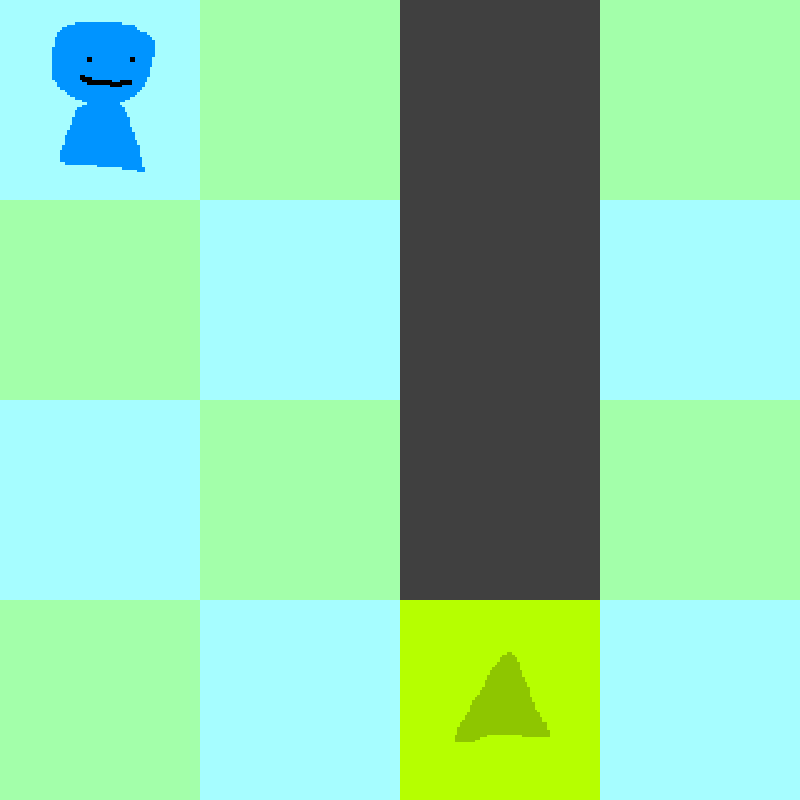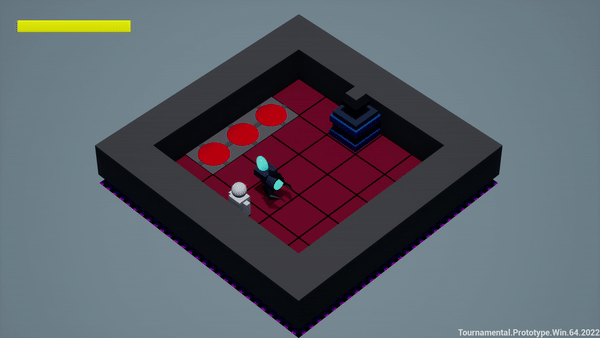TOURNAMENTAL
ROLE
Mechanics and Level Designer
DESCRIPTION
Tournamental is a data-driven, tile-based puzzle game where the player is tasked to reach the checkerboard tile to progress. The idea of the project was to develop our own unique mechanic for the game, as well as take someone else's and implement it ourselves using the documentation provided.
YEAR
GENRE
PLATFORM
2022
Puzzle
PC
SHOWCASE
As a part of two of our assignments, we were tasked with recording a handful of videos thoroughly explaining our mechanics, and how they were coded. Below you'll be able to find two videos explaining my moving blocks mechanic, as well as my recreation of Devyn Durden's Lightning Gun Mechanic.
POST-MORTEM
Introduction:
Tournamental is a data-driven, tile-based game made in Unreal Engine 4 of which we were tasked to document and develop a mechanic for it in Full Sail's Project and Portfolio 3 course, after doing so we were required to take another classmate's mechanic, and use the documentation provided by them to implement the mechanic ourselves.

What Went Right:
1) Understanding Tournamental: One of the greatest strengths I identified in myself was how easily I managed to grasp the logic of the foundation that was already built before I started working on the project, giving me the ability to swiftly start working on implementing features for the game without much real struggle. If there was a concept I needed clarification on it would normally be regarding the engine rather than the game itself, meaning that I was capable of swiftly searching for an answer on the internet.
2) Trello: Trello has been a tool with which I've been familiarized for a long time now, and didn't take me much time to set up the necessary cards to track and document my progress, ensuring that my Checklists were thorough, my descriptions went into as much depth as needed to describe my mechanics, and my comments easy to understand what changes were made during development.
3) Auto-Moving Blocks: My core mechanic were blocks that move a tile forward when certain conditions are met and can be rotated by using special Rotator Tiles and having the player interact with them. I felt really confident working on it and didn't encounter many issues while doing so, not to mention that I also ensured to make the mechanic as modular as possible by using Enumerators, Code Comments, and Instance Editable variables, giving level designers as many tools as needed to streamline adding these mechanics to a level, and any other coders the ability to add more functionality to them with ease.

4) Lightning Gun Peer Mechanic: For my peer mechanic I decided to go with Devyn Durden's Lightning Gun: a type of power-up that can be used to drain electricity off of special tiles known as Energy Pylons, which can then be shot back out to power other Pylons, changing the power state of whatever tiles they're bound to, such as Doors and Teleporter tiles which will be touched upon later. This mechanic didn't take me long at all to implement, giving me some time to provide an extra bit of polish to it, as well as solving a handful of edge-cases and making sure that, like my Auto-Moving Blocks, they were flexible and modular enough to allow the creation of extra power-ups later down the line, as well as ensuring that Energy Pylons interface properly with any new special tiles that may be added later on.
5) Extra Mechanics: With the extra time I had from working on the Lightning Gun, I decided to add a couple more unique tiles that can help expand both it and the Auto-Moving Blocks mechanic. Namely the addition of Doors and Pressure Plates: the former of which can only let a player through it if it's being powered by either an Energy Pylon or if the pressure plate bound to it has something standing on top of it. Other than that I took the time to implement a fairly fleshed-out Teleporter System, which allows anything on top of it to be teleported to any other tile in the level, including other teleporters without causing a sort of teleporting chain reaction. Like all my other mechanics, I ensured that these were visually interesting and extremely modular, one example of that being how Teleporters can be powered on/off by Energy Pylons and Pressure Plates, as well as them being color-coded and showing an "X" on the tile that they'll teleport to, as long as said tile isn't a Teleporter of the same color. Although the Teleporter mechanic was the most complicated to implement out of them all, I decided against making these the focus of my project as many others had already taken the task of implementing them into their own hands, and I wanted to present something that somewhat stands out.

What Went Wrong:
1) Deciding On Initial Mechanic: Before beginning to develop any mechanic into Tournamental, it took me some time to come up with an idea that I wanted to work on, first considering implementing breakable blocks and bombs mechanic similar to that found in the Bomberman series of games, and then the idea of creating some sort of mirror copy of the player character that will only appear when they're standing right in front of a special "Mirror" tile, which would move at the same time as the player and in the same direction, similar to Nitrome's Ditto. Finally, I decided to scrap both ideas due to me not being able to come up with any interesting puzzle mechanics that would utilize them, so I looked into Baba Is You for some inspiration and decided to stick with the idea of blocks that would move on their own, similar to what would happen when attaching the "is move" rule to any object in that game.
2) Peer Mechanic Miscommunication: Although the mechanic I chose for my project was really interesting and incredibly fun to work on, it wasn't really that well documented, with my only basis for it being the original Game Design Draft. I talked to my peer a handful of times, but they didn't feel too strongly about any of the ambiguous mechanics that were brought up to them, causing me to take some creative liberties when designing the mechanic, such as what the Lightning Gun was supposed to be exactly as well as the Energy Pylons; I also took the time to overhaul my copy of their Trello card, since as mentioned before, it lacked a fair amount of detail and information.
3) Feature Creeping: After implementing the Lightning Gun mechanic, the ability to introduce power-ups into the game really started to open my mind, helping me come up with countless abilities that could both let the player shoot special kinds of projectiles, as well as enhance their movement abilities. Enough that would give me enough material to spin Tournamental off into more than just a small project and make it a relatively-lengthy game with unique power-ups for each group of levels. Of course, this wasn't what the project was meant to be, and would ultimately reduce the time I had to make sure that I had playable levels and the presentation of the game was polished enough, so at the end of the day I voted against implementing them. However, that won't stop me from revisiting Tournamental later in the future and attempting to add them in my own time as means to practice my abilities with Unreal Engine 4's Blueprint Editor
4) Teleporter Bugs: Although it may seem like the most straightforward mechanic at first, the Teleporter tile was the hardest mechanic to implement out of the bunch from a relative point of view. Due to how the player and interactable objects handle tile movement, this made it a bit hard to ensure that the teleportation happens smoothly with an animation that properly conveys what's occurring, as well as preventing any objects from overlapping each other in any form when doing so, preventing the player from moving when the teleportation is taking place, and avoiding any form of chain reaction when teleporting to another teleporter tile. At the end of the day, all these bugs were somewhat efficiently taken care of and are not present in the current build of the project.
5) Project Multitasking: at the time of working on Tournamental we had another course going on simultaneously, which tasked us with creating a mechanic, as well as a level featuring said mechanic, for a different, physics-driven platformer game. This made it slightly hard to focus on both at a time since not only were both games quite different in structure but were also of similar magnitude, making me take more time to get my assignments for both courses done than I would've liked to.

In Conclusion:
Working on Tournamental helped me increase my confidence when working on Unreal Engine 4, as this was my first project in which I actively developed my own features from the ground-up, as well as allowed me to better my creativity by both coming up with my own mechanics within certain restrictions, as well as taking someone else's mechanic and implementing it into a project myself.